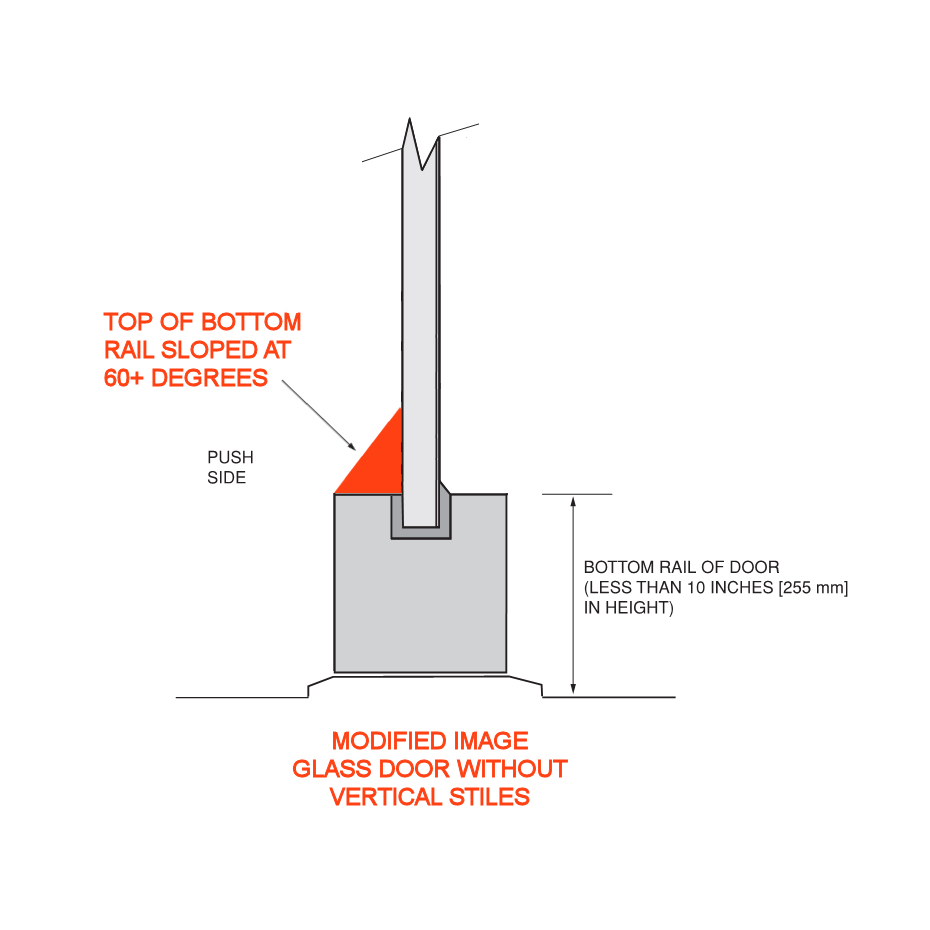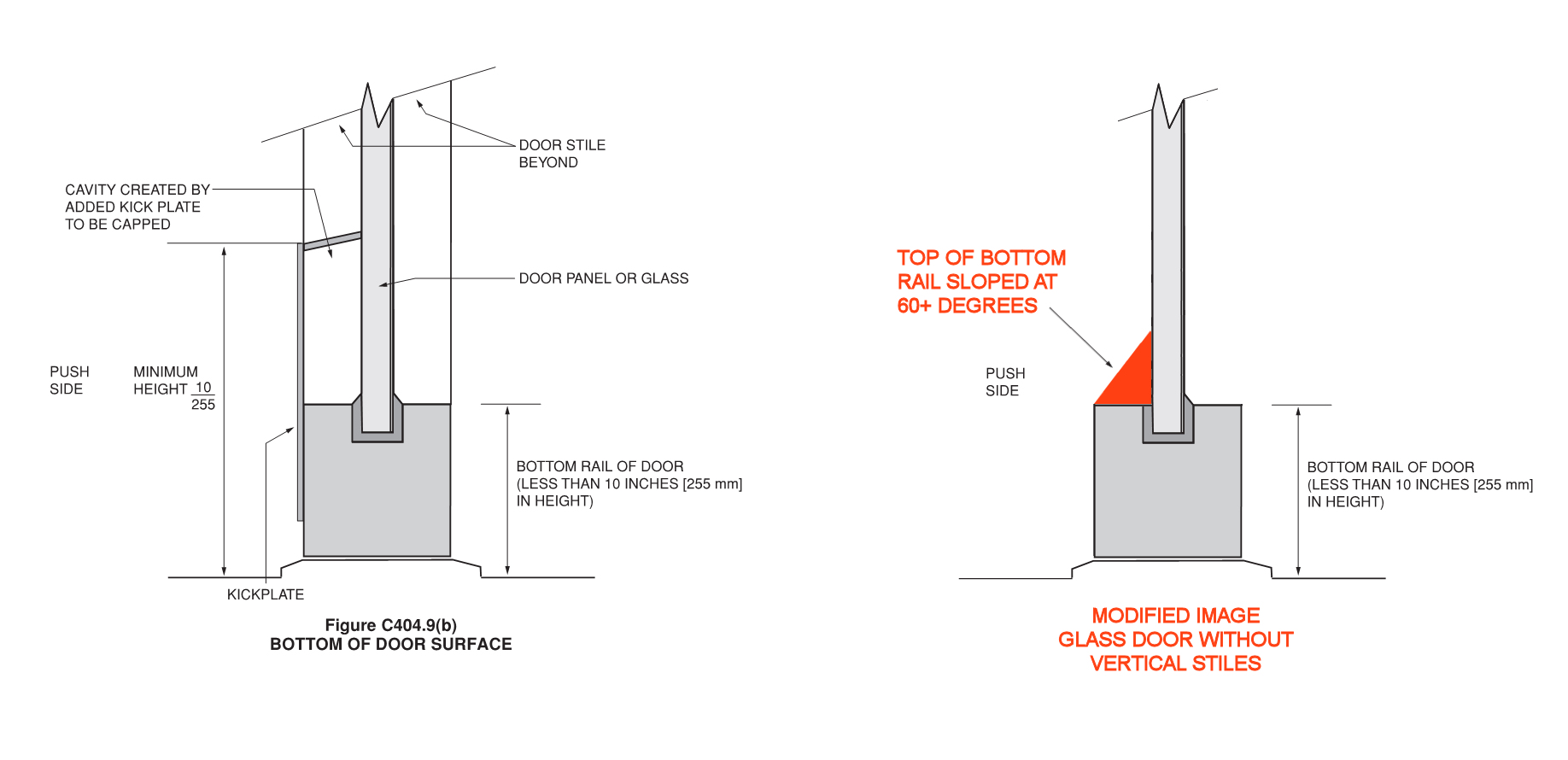Last week, an AHJ asked me if I knew of a source for plates or other products that could be used to increase the height of the bottom rail of a door. If you’re not familiar with this application, the accessibility standards require a 10-inch-high flush, smooth surface (measured up from the floor) on the push side of manually operated doors. A kick plate can be used to increase the height of the bottom rail, but cavities must be capped, and the kick plate must extend to within 1 inch of the sides and bottom of the door and at least 10 inches up from the floor.
The drawing on the left below is from the Commentary edition of ICC A117.1 – Standard for Accessible and Usable Buildings and Facilities. It shows a door with a narrow bottom rail and the applied kick plate that is capped at the top. The AHJ’s question was where this type of plate could be purchased.
I want to take this opportunity to point out another potential modification that can be used on all-glass doors. If the glass door has a bottom rail running across the door width and does not have vertical stiles (this type of door is shown here), the accessibility standards do not require a 10-inch high smooth surface if the top of the bottom rail is sloped. There is an exception in both the ADA standards and in ICC A117.1: Tempered glass doors without stiles and having a bottom rail or shoe with the top leading edge tapered at no less than 60 degrees from the horizontal shall not be required to comply with the 10-inch (255 mm) bottom rail height requirement. Note that this exception addresses only the 10-inch height requirement – the prohibition on protruding hardware in this area would still apply.
The drawing on the right below is a modification I made to show that on a glass door with no vertical stiles, a sloped cap could be added at the top of a non-compliant bottom rail.
The AHJ will be checking this post to see if we can be of any help, so the question is this…is there a source for these products? Either a kick plate for a stile and rail door with a means of closing the resulting cavity, or a sloped “cap” for the bottom rail on an all-glass door without vertical stiles?
WWYD?
You need to login or register to bookmark/favorite this content.







I believe the Trimco KH050 kick plate would do the trick.
I know of one company that still makes a bottom-of-door adapter for older a/g drs w/ short bottom rails: sbhsolutions.com in Southern California, and it’s their “10AD” plate. Custom-configured per door, the brake-formed aluminum panels set atop the bottom rail and between the stiles, are flush at the top — i.e., no cavity — are formed to set flush with the stiles & rails, and are fastened w/ double-sided tape. Not cataloged now, you have to “call and ask”. They became very popular out here in the early 80’s with the advent of affording accessibility.
I believe Rockwood Manufacturing (Div. of ASSA ABLOY) has been making custom kickplates for full glass stile & rail doors for some years now.
“Any” sheet metal fabricator could make such a specialized kickplate. The companies that do stainless steel work for kitchens, etc. could easily field measure, cut to size, slit and bend (maybe even with a return hem at the top to avoid sharp edges).
It would be custom work, but not very hard.
Some protection plate manufacturers do offer a plate like the one shown above left, even though they do not show it in their catalog or price book. You just need to contact them with the desired plate height & width and the door information such as the glass width and stile width.
Trimco has been making these for years.
WA-A is a one side return plate.
Custom made to pretty much any dimensions.
Thanks Dan!
– Lori
Just food for thought: You may want to put a piece of blackout film on the glass area that will be covered by the new plate. If not, the glass will get dirty and there is no way to clean it.
Great idea, Alex!
– Lori
Lori:
you say that “Note that this exception addresses only the 10-inch height requirement – the prohibition on protruding hardware in this area would still apply.” In this case would the protrusion be measured from the face of glass or face of the bottom rail?
Good question…I would guess that the bottom rail would be considered the flush surface – it would just be shorter than 10 inches. But no protrusions are allowed in the area measured from the floor up 10 inches.
– Lori